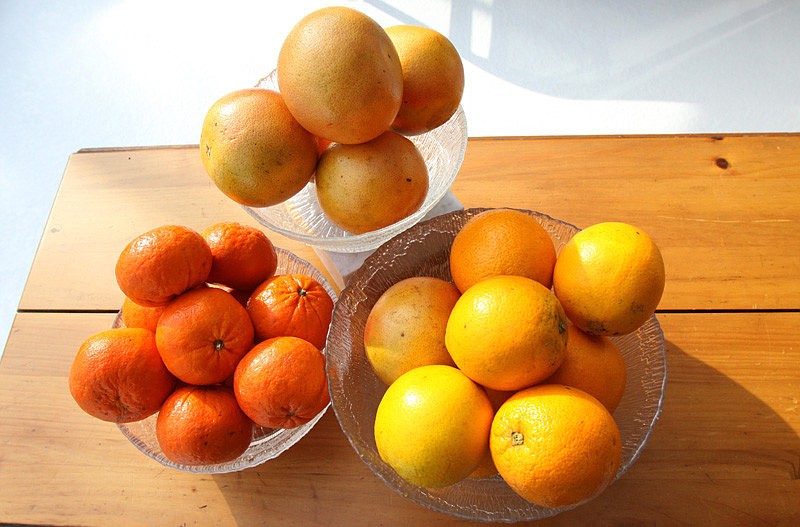- April 18, 2024
-
-
Loading

Loading

Winter in Florida is a virtual parade of edible sunshine. First, starting in late fall, come the navel oranges and ruby red grapefruit, followed by tangerines. In January — and only in January — the much-coveted Honeybells appear. Crimson grapefruit follow for a brief period in February. Then Valencia oranges and golden white grapefruit finish out the season, which ends in May. These are the stars of Florida’s fruit season. Even the names are mouthwatering. The fruit is as healthful as it is delicious, and its season is one of the joys of living here.
Whether you get your citrus in the supermarket, from a grower or from a tree in your backyard, these fruits are virtually guilt-free. They are universally low in calories and sodium (with the peculiar exception of kumquats) and rich in vitamins A, B and C and various other nutrients. They have a decent amount of dietary fiber and zero grams of fat. Sugar content ranges from two to three grams each for a lime or lemon to eight grams for an orange and 11 for a tangerine. From a nutrition and taste standpoint, they are real winners.
They are also stars in the kitchen with roles to play far beyond juice or the conventional half-grapefruit-sectioned-for-breakfast. That same half grapefruit can take a topping of light brown sugar straight from the package, go under the broiler until the sugar bubbles and emerge as an instant dessert. Got leftover champagne? Martha Stewart pours it over citrus sections in saucer glasses for another instant ending. Or bake a sweet tart base, spread with marscapone mixed with some finely chopped candied ginger, a bit of grapefruit juice and some confectioners sugar, top with perfect grapefruit sections, and you have a spectacular dessert with little effort.
Citrus fruits shine in salads, in which oranges and onions are especially great companions. One recipe follows. For an intriguing variation, combine oranges with watercress and red onion, pine nuts and an olive oil/red wine vinegar dressing seasoned with a bit of dried marjoram. Individually or in combination, citrus fruits star in sorbets and other desserts, drinks, preserves, cakes, cookies, tarts, spectacular scones and more. These may well be the most versatile of fruits. Epicurious.com delivers 117 citations for “grapefruit” alone; recipes are that easy to find.
So is great fruit, because Sarasota has a major, local grower — Albritton Fruit Company. It was founded by Karl Albritton in 1880 and calls itself Florida’s oldest family-owned business. And well it might; it buds onto rootstock from a sour orange tree planted during the Civil War. Today’s management is the third generation.
Albritton grows in Sarasota, Arcadia and Hardy counties; its business is roughly 50% wholesale and 50% retail. There used to be multiple Albritton stores, including a sorely missed one on Longboat Key and another on South Tamiami Trail not far from the hospital. Today shipping is 90% of its retail business (they send fruit worldwide), and there is only The Grove on Proctor east of Honore. But you can still get a free taste of its 100% pure orange or grapefruit juice.
If you are a Honeybell fancier, get over there straightaway: The fruit is here, but the season is short. Whatever you are buying, consider this advice from Tom House, Albritton Fruit’s general manager, “People buy fruit by look and size,” he says, “and those things don’t really matter. (It’s) better to judge by density; heft the fruit and get a sense of how juicy it is.”
House explains that although wholesale customers buy a year ahead then test the actual crop for sugar and acidity to meet their standards, “What we sell in the store, we select by taste and experience. We eat, pick, ship.”
To experience just how sweet and juicy a fruit of winter can be, take an early tangerine, for example, which can be hard to peel. Split it in half and eat it from the inside out — standing over a sink or wastebasket to catch the juice that runs off your chin. You’ll be doing it kind of like the citrus guys do it in the field. It’s messy, but it sure is fun — and delicious!
ORANGE AND ONION SALAD
SERVES 4
4 small oranges
1 small onion peeled
1/4 cup olive oil
2 tablespoons red wine vinegar
1 clove garlic, cut in half
1/4 teaspoon salt
Freshly ground black pepper
Crisp salad greens
1/2 cup pitted green olives (optional)
• Peel oranges and remove membranes. Slice oranges and onion into thin slices and separate onion slices into rings.
• Combine olive oil, vinegar, two tablespoons water, garlic, salt and pepper. Stir well, pour over oranges and onion and refrigerate, covered, until well-chilled — two hours or more. Remove and discard garlic.
• Put greens (and olives, if using) in salad bowl. Add orange/onion/dressing mixture, toss well and serve.